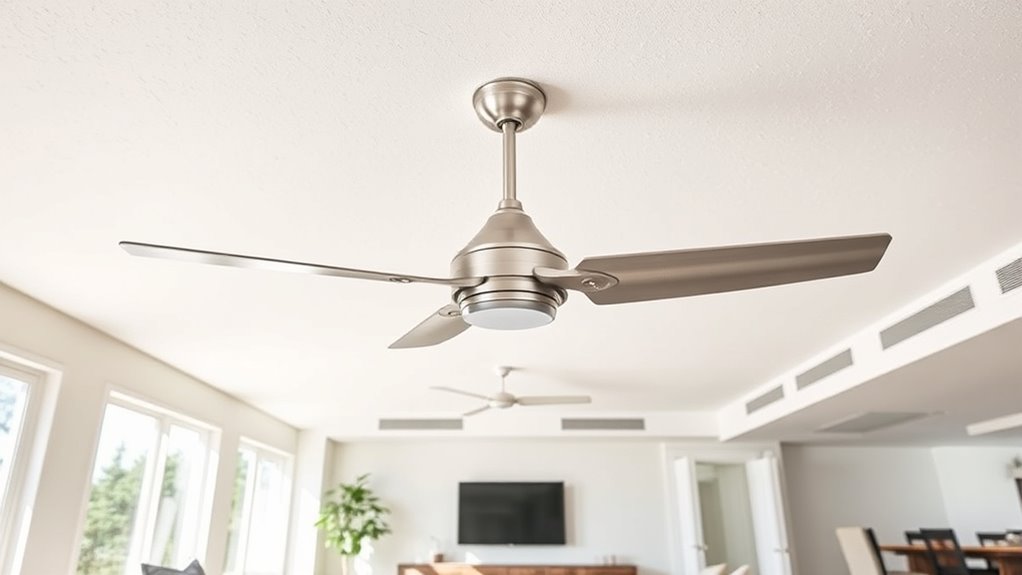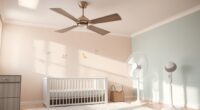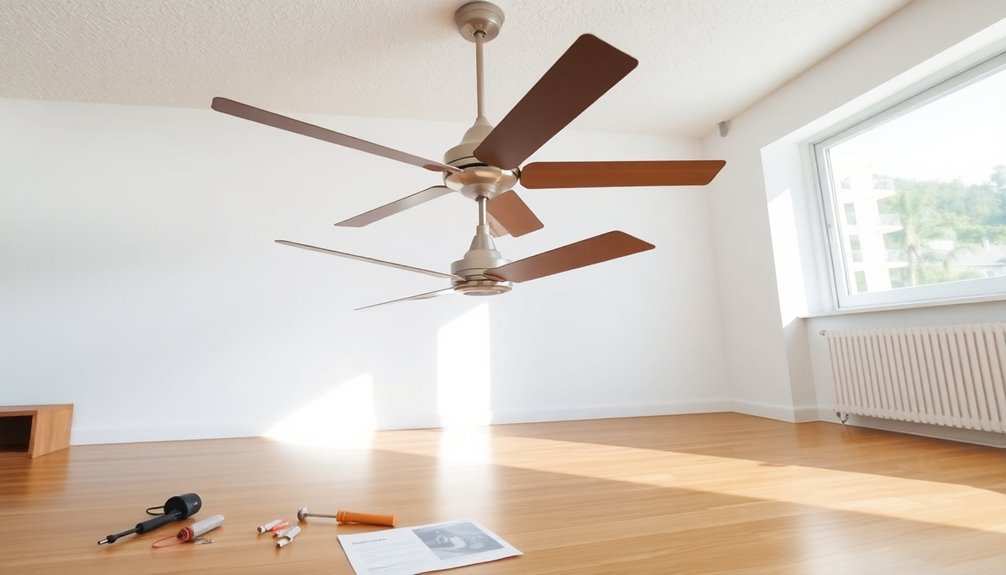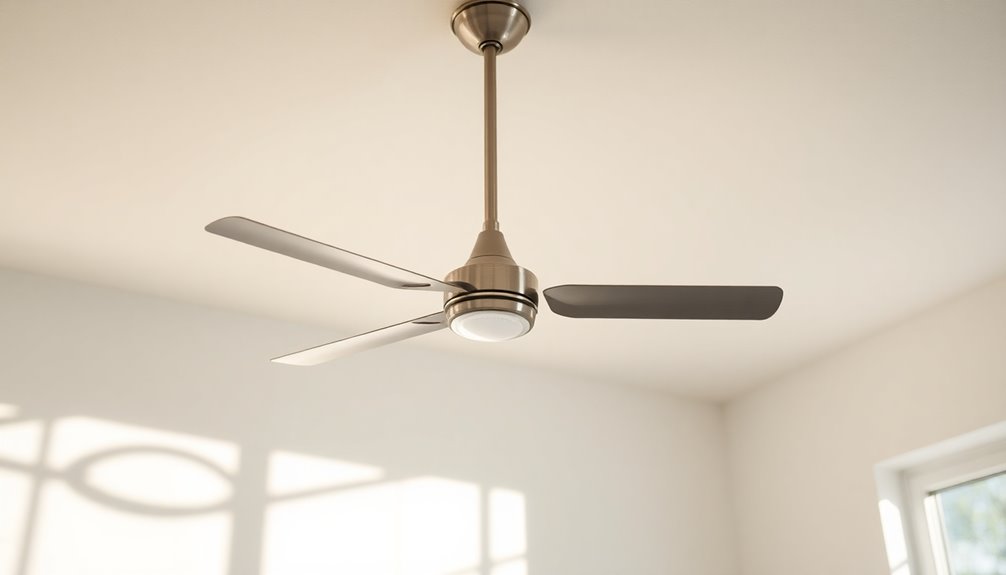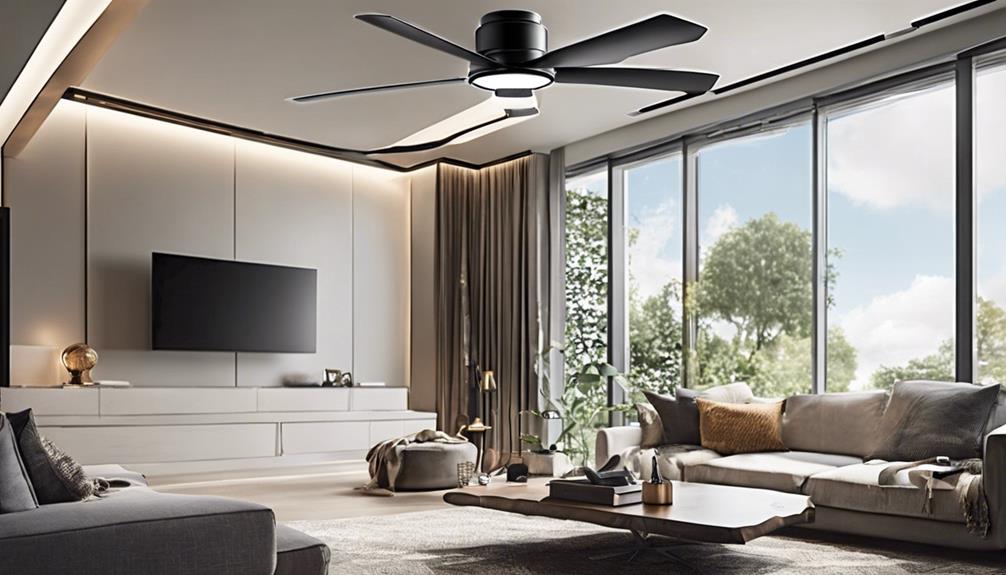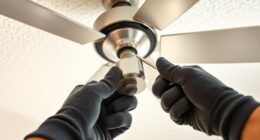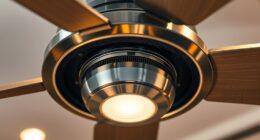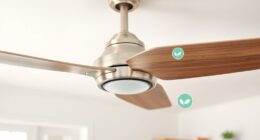Ensuring proper fan height safety clearance is essential to prevent accidents, improve airflow, and meet safety standards. Typically, fans should be mounted about 8-9 feet above the floor, with blades at least 7 feet high for safety. Too low can cause injuries or wobbling, while too high reduces efficiency. Accurate measurements and proper installation help keep your space safe and comfortable. Keep exploring to discover more tips for ideal fan placement and safety.
Key Takeaways
- Maintain at least 7 feet of clearance from floor to fan blades for safety and optimal airflow.
- Use manufacturer guidelines to determine appropriate fan height based on room size and ceiling height.
- Proper mounting prevents wobbling, noise, and accidental contact with moving blades.
- Adjust fan height after installation to ensure safe clearance and efficient operation.
- Regularly inspect and verify that fan height meets safety standards to prevent injuries and airflow issues.
Understanding the Importance of Fan Height Safety Clearance
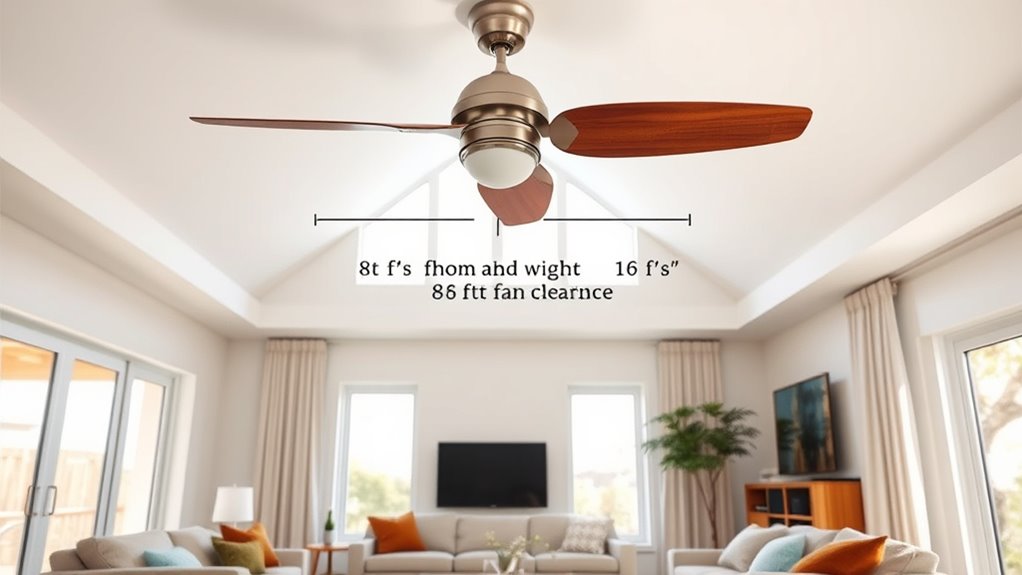
Understanding the importance of fan height safety clearance is crucial because it helps prevent accidents and injuries. Proper blade clearance ensures that the fan operates safely without hitting objects or people below. Maintaining adequate fan elevation keeps blades at a safe height, reducing the risk of contact. If a fan is installed too low, you might accidentally bump into the blades or cause damage. Conversely, a fan that’s too high might not circulate air effectively. Ensuring correct blade clearance and appropriate fan elevation improves safety and performance. Always check manufacturer guidelines to determine the right height, and remember that proper clearance minimizes hazards, making your space safer for everyone. Prioritizing these factors is essential for a secure and efficient ventilation setup. Additionally, understanding fan technology can help you select the most suitable model for your space and safety needs.
Standard Height Recommendations for Ceiling Fans
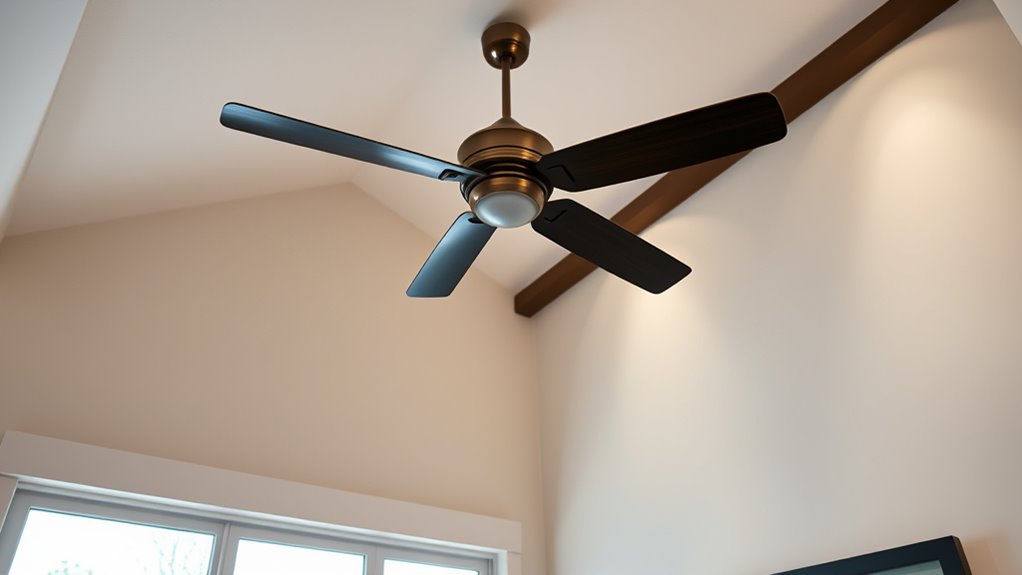
Knowing the standard height recommendations helps you guarantee your ceiling fan operates safely and efficiently. You should consider typical mounting heights, room size, and overall clearance to find the right fit. Staying within these guidelines keeps your space comfortable and minimizes safety risks. Additionally, ensuring the fan’s blades are at an appropriate height clearance reduces the risk of accidents and maintains optimal airflow.
Typical Mounting Heights
Have you ever wondered what the ideal height is for mounting a ceiling fan? Typically, the standard mounting height ranges from 8 to 9 feet above the floor. This height balances fan aesthetics with functionality, ensuring the fan looks proportional and performs efficiently. If you mount it too low, you might notice increased fan noise levels and a potential safety hazard. Conversely, placing it too high can reduce airflow and comfort. For excellent performance, the blades should be about 7 feet above the floor, with 8-9 feet being the most common. This height offers a good blend of safety, noise control, and visual appeal, helping you maximize your ceiling fan’s benefits without sacrificing style or safety.
Room Size Considerations
Room size plays a essential role in determining the ideal height for mounting your ceiling fan. Larger rooms benefit from fans installed slightly lower for better air circulation, while smaller rooms require higher placements to avoid crowding. Consider how your fan’s height impacts room aesthetics—an appropriately positioned fan complements your decor and fan color options. To visualize, here’s a simple guide:
| Room Size | Mounting Height | Aesthetic Tip |
|---|---|---|
| Small (up to 150 sq ft) | 8-9 feet above floor | Use fans that blend with ceiling color |
| Medium (150-300 sq ft) | 9-10 feet above floor | Match fan style with room decor |
| Large (over 300 sq ft) | 10-11 feet above floor | Consider larger fans for better airflow |
Proper refrigeration cycle understanding can also influence your ventilation choices, ensuring optimal air movement and efficiency.
Ceiling Fan Clearance
To guarantee safe and effective airflow, ceiling fans should be installed at standard heights that provide adequate clearance from the floor and surrounding objects. Typically, the fan motor should be at least 7 feet above the floor to prevent accidental contact. For rooms with standard 8-foot ceilings, mounting the fan approximately 8-9 feet high achieves this clearance. The blade design also influences the ideal height; longer blades require more clearance to avoid obstructions. If your ceiling is higher, consider a downrod to lower the fan for proper airflow and safety. Proper clearance assures the fan operates efficiently without risking injury or damage. Adhering to these guidelines helps maximize airflow and safety while maintaining the fan’s performance. Additionally, understanding the standard ceiling height can help you determine the best fan placement for your space.
Factors That Influence Optimal Fan Placement

Several key factors influence the ideal placement of a ceiling fan, guaranteeing it operates safely and efficiently. Fan aesthetics and ceiling aesthetics play a big role in determining the best spot. You want the fan to complement the room’s design without compromising safety or airflow. The size and shape of the fan should match the room’s dimensions for balanced aesthetics and optimal circulation. Ceiling height is essential—too low, and it becomes a hazard; too high, and it loses effectiveness. Also, the fan’s location should avoid obstructions and ensure even air distribution. Considering these factors helps you find a placement that enhances your space’s look while providing the ventilation you need, all without risking safety or sacrificing style. Additionally, understanding regional holiday customs can influence the timing and decoration choices for your fan installation during festive seasons.
Risks of Installing Fans Too Low or Too High
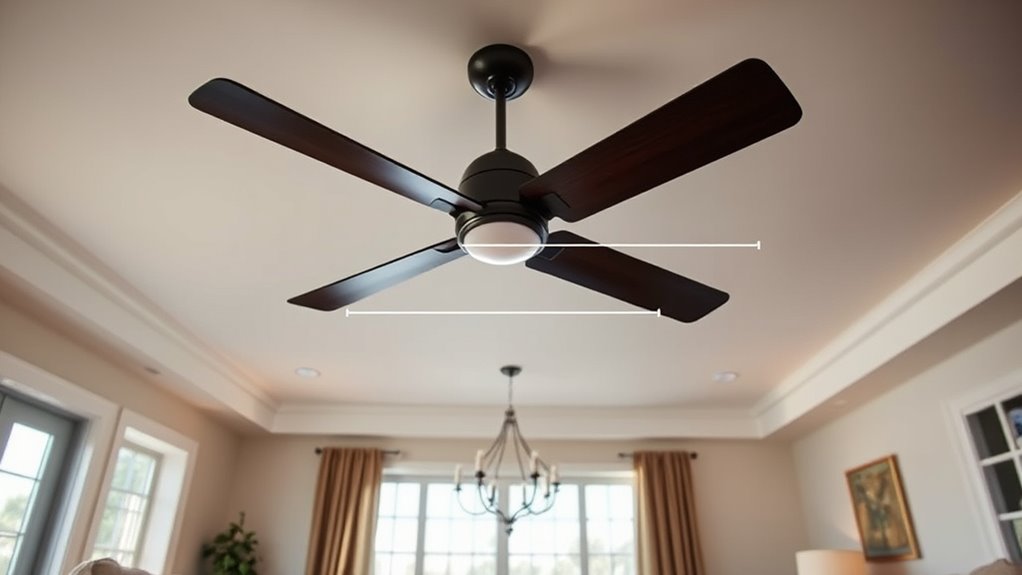
Installing a ceiling fan at the wrong height can pose serious safety risks and reduce its effectiveness. Many fan height myths suggest that lower is always better or that higher is unnecessary, but these installation myths can lead to hazards. If a fan is installed too low, you risk hitting it or causing injury, especially in rooms with high ceilings. Conversely, too high and the fan won’t circulate air efficiently, leading to poor ventilation and increased energy costs. Misconceptions about fan height may tempt you to ignore proper guidelines, but improper installation compromises safety and comfort. Ensuring your fan is correctly positioned isn’t just about aesthetics—it’s about preventing accidents and optimizing airflow. Proper fan height guidelines are essential for safety and efficiency, and ignoring them can lead to costly mistakes. Don’t fall for installation myths that could jeopardize your safety or diminish your fan’s performance.
How to Measure the Correct Fan Height in Your Space

To gauge the correct fan height, start by noting the distance from the ceiling to the floor. Keep in mind the fan blade length to guarantee proper clearance and airflow. Also, consider how you’ll use the room to decide the ideal height for safety and comfort. Ensuring the fan height promotes sustainable living by optimizing energy efficiency and airflow can further enhance your space’s comfort and sustainability.
Measure From Ceiling
Measuring from the ceiling is a straightforward way to guarantee your ceiling fan hangs at the ideal height. Start by turning off the fan and using a tape measure to determine the distance from the ceiling to the desired fan height, typically 8 to 9 feet above the floor. Confirm the fan’s blades are at least 7 feet above the floor for safety and efficiency. When installing, consider how remote controls affect placement—keeping remotes within reach without interfering with fan motor issues or clearance. Use a ladder if needed for accuracy. Proper measurement prevents problems like wobbling or fan noise, ensuring safe operation and longevity. Taking precise measurements now saves you from costly adjustments later and keeps your space comfortable and safe. Additionally, understanding the effectiveness of proper fan height can optimize airflow and energy efficiency in your room.
Consider Fan Blade Length
Since the fan blades extend below the motor housing, you need to account for their length when determining the correct fan height. Measure the blade length carefully, as it directly affects the overall fan size and clearance needed. A larger fan size with longer blades may require additional height to ensure safety and ideal airflow. Keep in mind that the blade length varies between models, so always check the specifications before installation. To maintain proper clearance, add the blade length to the motor housing height, ensuring the blades don’t hang too low or risk hitting objects or people. Properly considering blade length helps you select a fan height that balances safety, comfort, and efficient ventilation for your space. Additionally, understanding fan blade length can aid in choosing the right size to match your room’s proportions and ceiling height.
Account for Room Usage
Understanding how your space is used is essential for determining the ideal fan height. Different rooms serve various functions, so consider how you’ll use the space—whether it’s for relaxing, dining, or working. In living areas, a lower fan might improve airflow, but it shouldn’t obstruct views or interfere with ceiling fan aesthetics. For bedrooms, you want a height that balances comfort and safety, avoiding head bumps. When choosing a fan, consider fan color choices that complement your decor, creating a cohesive look. Remember, the correct height enhances both safety and style, ensuring the fan functions efficiently without compromising room aesthetics. Proper measurement based on room usage helps you find the perfect balance between form and function. Additionally, understanding airflow dynamics can help you optimize your fan placement for maximum comfort.
Impact of Fan Height on Air Circulation and Energy Efficiency
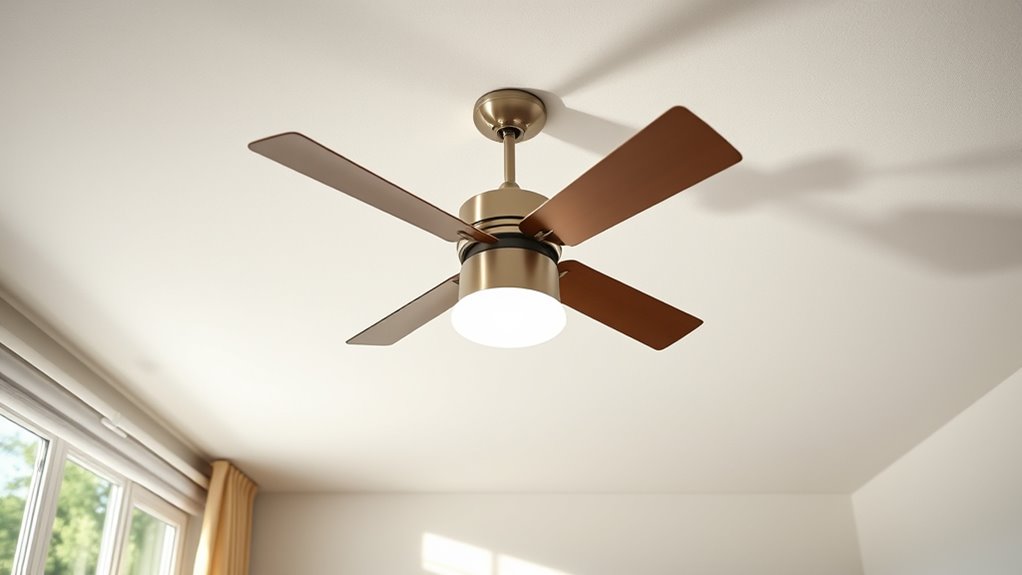
The height at which a fan is installed directly influences how effectively it circulates air and conserves energy. If your fan is too high, it won’t move air efficiently, leading to poor air circulation and increased energy use as the system works harder to cool or heat the room. Conversely, installing the fan too low can cause discomfort and safety concerns, but ideal height ensures maximum airflow and energy efficiency. Properly positioned fans create a gentle breeze that distributes air evenly, reducing the load on your HVAC system. This balance helps you save on energy costs while maintaining a comfortable environment. The right fan height enhances overall air circulation, making your space more energy-efficient and comfortable.
Common Mistakes to Avoid When Installing Ceiling Fans
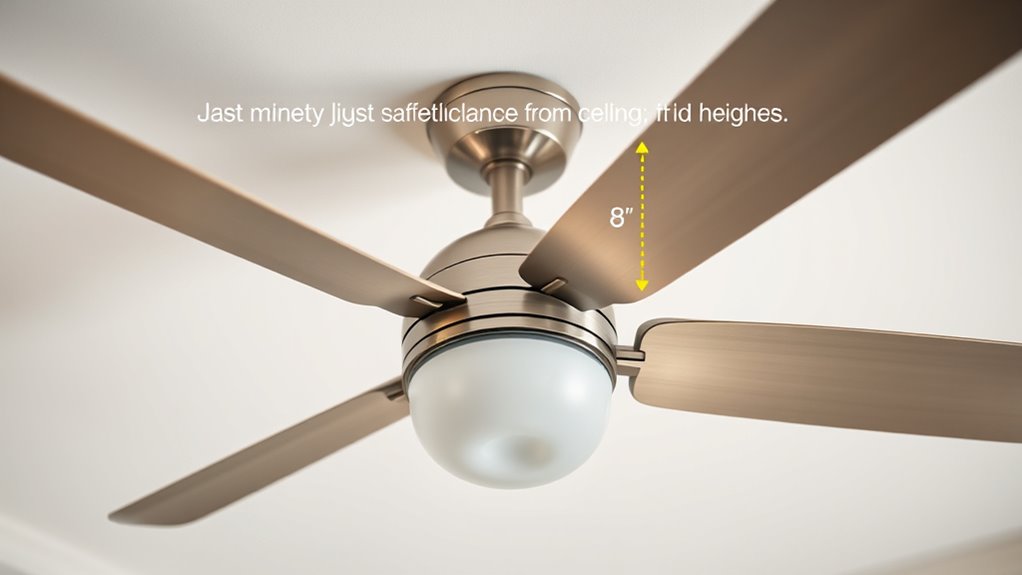
When installing a ceiling fan, avoid mounting it too low or too high, as incorrect height can cause safety issues and poor airflow. Don’t overlook safety standards or forget to check blade clearance, which can lead to accidents or damage. Paying attention to these common mistakes helps guarantee your fan operates safely and efficiently. Additionally, considering AI-driven solutions can optimize the installation process and ensure compliance with safety guidelines.
Incorrect Mounting Height
Installing a ceiling fan at the wrong height can considerably reduce its effectiveness and pose safety risks. Many believe fan height myths, like thinking you can install it anywhere or that DIY installation doesn’t require precise measurements. In reality, proper mounting height is vital for proper airflow and safety. If you mount your fan too high, it won’t circulate air effectively, making the room uncomfortable. Too low, and you risk hitting the blades or chandelier. When installing yourself, measure carefully and follow manufacturer guidelines. Avoid shortcuts or guesswork, as incorrect mounting height can lead to wobbling, noise, or accidents. Ensuring your fan is installed at the correct height maximizes its efficiency and keeps you safe. Proper planning and accurate measurements are key to a successful installation.
Overlooking Safety Standards
Overlooking safety standards during ceiling fan installation is a common mistake that can lead to serious hazards. If you ignore proper guidelines, you risk creating safety issues, such as fans placed too low or in unsafe positions. This oversight can also affect fan aesthetics, making your space look cluttered or unbalanced. Additionally, improper installation often results in increased fan noise, which becomes a constant annoyance. To avoid these problems, always follow manufacturer instructions and safety codes. Confirm the fan’s height and positioning meet recommended standards for clearance and stability. Paying attention to safety standards not only protects you but also ensures the fan operates quietly and looks good in your space. Proper installation is essential for both safety and ideal fan performance. Incorporating innovative materials can further enhance the durability and safety of your ceiling fan setup.
Poor Blade Clearance
Poor blade clearance is a common mistake that can substantially impact the safety and performance of your ceiling fan. Too little clearance can cause blades to wobble, increase noise, or even pose a safety risk. To avoid this, pay attention to your fan height and blade clearance. Here are key points to consider:
- Ensure the blades are at least 7 feet above the floor for safety and clearance.
- Maintain a minimum of 10-12 inches between the blades and any nearby walls or furniture.
- Adjust the fan height if needed, so blades don’t interfere with ceiling fixtures or obstructions.
- Incorporating automation technologies can help monitor and maintain optimal fan operation.
Proper blade clearance not only improves airflow but also prevents accidents. Always measure carefully to guarantee ideal fan height and blade distance for safe, efficient operation.
Tools and Techniques for Safe Fan Installation
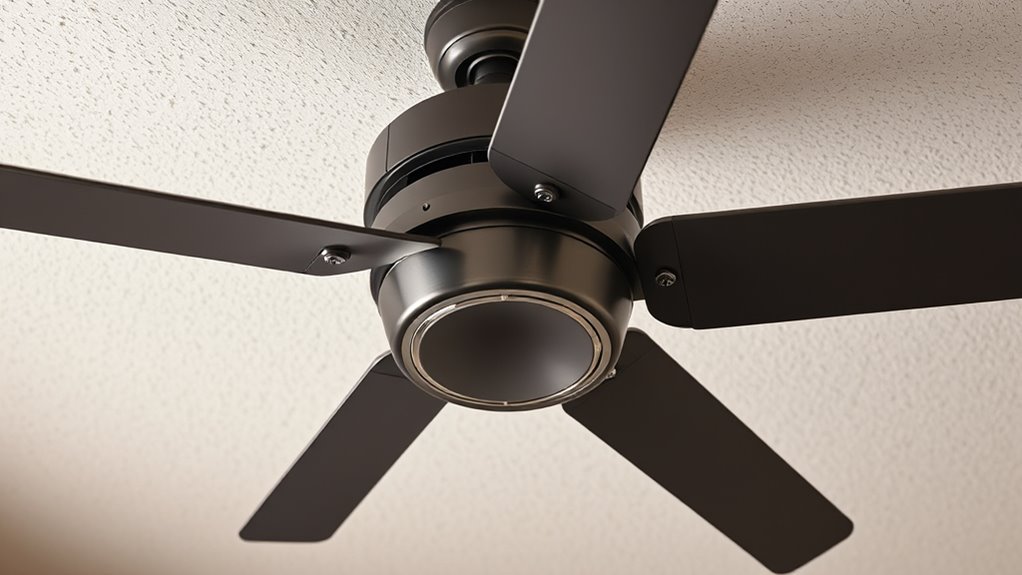
To guarantee a safe fan installation, you need to use the right tools and follow proper techniques. Wireless tools, like cordless drills and remote sensors, make the process more efficient and reduce clutter. Always start by securely mounting a sturdy ladder or scaffold to reach the ceiling comfortably. Use a level to ensure your fan is perfectly aligned, preventing wobbling and unsafe vibrations. When handling decorative accessories, such as light fixtures or fan blades, use gloves to avoid damage or injury. Double-check all connections and mounting brackets before powering up. Remember, safety comes first—don’t rush, and follow manufacturer instructions carefully. Proper tools and techniques help you install your fan securely and safely, minimizing risks and ensuring ideal airflow. Incorporating professional techniques from experienced installers can further enhance safety and efficiency during installation.
Adjusting Fan Height After Installation for Maximum Safety
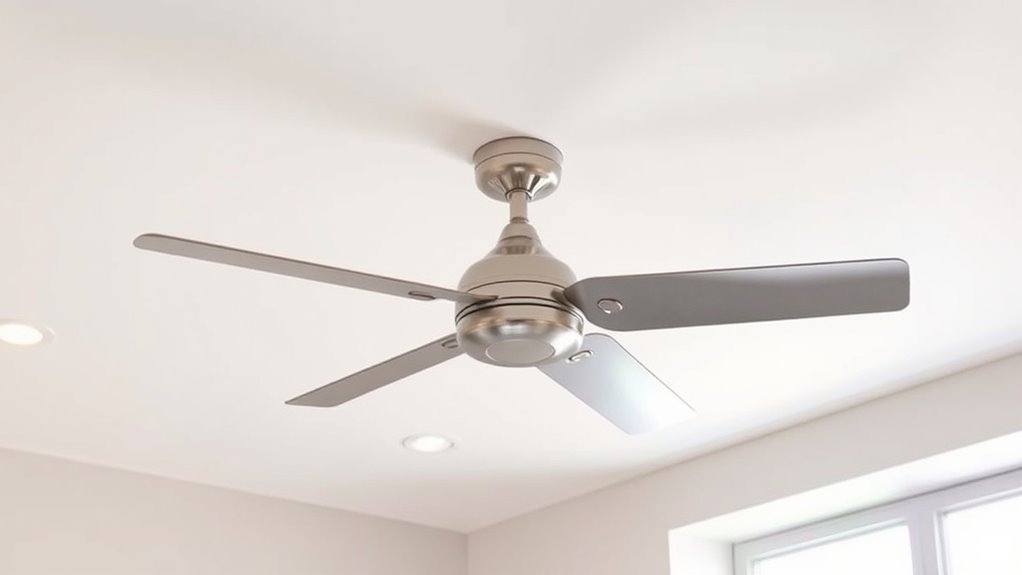
After installing your ceiling fan, it’s important to make certain it hangs at the correct height for safety and ideal performance. Adjusting the height ensures safe clearance and maximum airflow. First, use your remote control to turn the fan off and disconnect the power if needed. Then, follow these steps:
- Check the current fan height and compare it to safety standards—typically 7 feet above the floor.
- If adjustable, loosen the mounting bracket to raise or lower the fan until it’s at the recommended height.
- Reconnect power, turn the fan on, and adjust the fan speed to test for smooth operation and proper clearance.
Always ensure the fan blades are at least 8-9 feet above the floor for safety and efficient ventilation.
Professional Tips for Ensuring Safe and Effective Ventilation
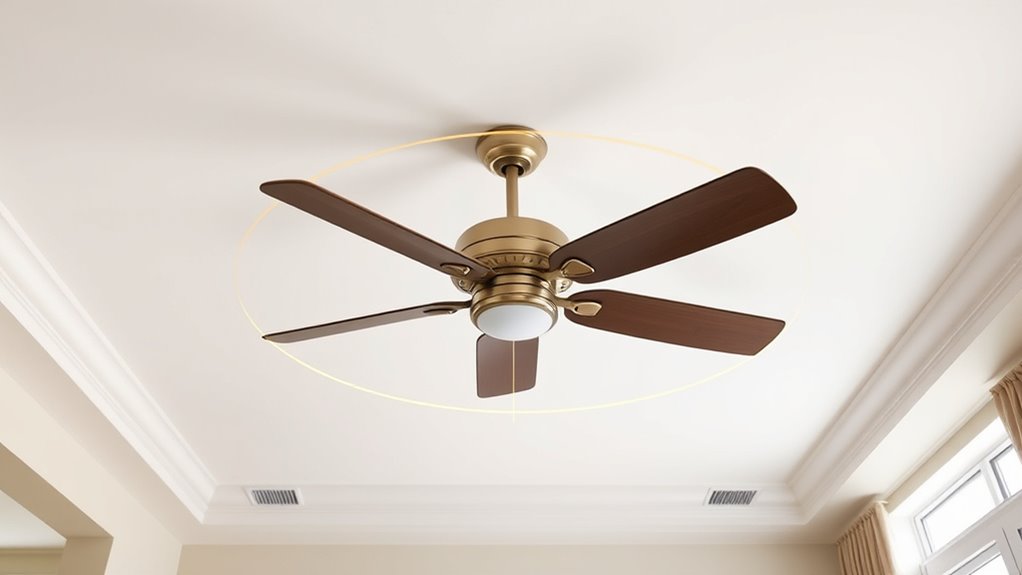
Proper ventilation is essential for maintaining indoor air quality and ensuring your space feels fresh and comfortable. To achieve this, focus on professional tips that prioritize both safety and efficiency. Consider fan design to maximize airflow and minimize noise, enhancing comfort. Aesthetic considerations matter too; choose fans that complement your decor without compromising safety. Ensure the fan’s height aligns with safety clearance standards for peak performance. Regularly inspect connections and blades to prevent hazards. Additionally, select fans with safety features like protective grills. Keep airflow unobstructed by furniture or décor.
| Tip | Focus Area | Benefit |
|---|---|---|
| Choose safe fan design | Fan design | Improved airflow and safety |
| Match aesthetic style | Aesthetic considerations | Enhanced decor integration |
| Maintain proper height | Fan height safety clearance | Consistent safety standards |
| Regular inspections | Safety maintenance | Prevent accidents |
Frequently Asked Questions
Can Ceiling Fan Height Affect Room Acoustics?
Yes, ceiling fan height can affect room acoustics. When a fan is installed too high, sound reflection from the ceiling can amplify noise, making it seem louder. Conversely, a properly placed fan helps reduce noise by minimizing sound reflection and promoting better airflow. You’ll notice improved noise reduction and clearer sound quality, creating a more comfortable environment. Adjusting the fan height can make a significant difference in your room’s acoustics.
How Does Ceiling Fan Height Influence Lighting Fixtures?
You might not realize it, but the height of your ceiling fan directly impacts your lighting fixtures. If your fan hangs too low, it can block the light or obscure the fixture’s visibility, creating shadows or uneven illumination. Proper lighting placement depends on the fan’s height, ensuring the fixture is clear and functional. Adjusting the fan height can reveal the fixture’s true brilliance, transforming your room’s ambiance effortlessly.
Are There Specific Regulations for Fan Height in Commercial Spaces?
You need to follow building codes and safety standards when installing fans in commercial spaces. These regulations specify minimum and maximum fan heights to ensure safety, proper airflow, and compliance. Typically, commercial spaces require fans to be mounted at heights that prevent contact and allow safe operation. Always consult local codes and manufacturer guidelines to determine the correct height, and avoid shortcuts that could compromise safety or violate regulations.
What Are Signs of Improper Fan Height Installation?
You might notice uneven airflow or excessive noise, hinting at improper fan height installation. Signs include misaligned fan blades or wobbling, which suggest poor fan blade alignment. Additionally, if the fan feels unstable or shifts when in use, it indicates mounting stability issues. These signs warn you that the fan might be too low or improperly secured, risking safety and performance. Addressing these issues guarantees safe, efficient ventilation.
How Often Should Fan Height Be Re-Evaluated After Installation?
You should re-evaluate fan height adjustment annually or if you notice any issues like unusual noise, wobbling, or reduced airflow. Regularly checking against installation guidelines guarantees safety and peak performance. Changes in room layout, renovations, or ceiling structure may require adjustments. Always verify that the fan remains within the recommended height, adhering to installation guidelines to prevent hazards and maintain proper ventilation and comfort in your space.
Conclusion
Ensuring the right fan height isn’t just about comfort—it’s about safety too. Did you know that improperly installed fans can cause injuries or reduce airflow efficiency? By following proper guidelines and taking your time during installation, you can prevent accidents and enjoy ideal ventilation. Remember, a small mistake in height can lead to big safety issues. Stay informed, measure carefully, and prioritize safety to keep your space cool and secure.
